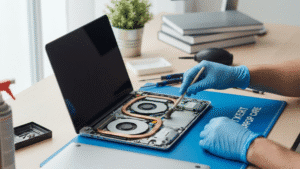Introduction:
It’s a common scenario: you plug in your phone to charge, but nothing happens. Dealing with a phone that won’t charge can be frustrating, especially if you rely on your device for communication, work, or entertainment. However, before rushing to the nearest repair shop, there are several troubleshooting steps you can take to identify and potentially resolve the issue. In this guide, we’ll explore what to do when your phone won’t charge and how to troubleshoot common charging problems.

- Check the Charging Cable and Power Adapter:
The first step is to ensure that the charging cable and power adapter are working correctly. Inspect the cable for any signs of damage, such as frayed wires or bent connectors. Likewise, check the power adapter for any physical damage or debris that may be obstructing the charging port. If possible, try using a different charging cable and power adapter to see if the issue persists. - Clean the Charging Port:
Over time, dust, lint, and debris can accumulate in the charging port of your phone, preventing a proper connection with the charging cable. Use a can of compressed air or a soft brush to gently clean the charging port, removing any debris that may be obstructing the connection. Be careful not to damage the port while cleaning. - Restart Your Phone:
Sometimes, a simple restart can resolve software glitches or temporary issues that may be preventing your phone from charging. Power off your device completely, wait a few seconds, and then power it back on. After restarting, try plugging in the charger again to see if the problem persists. - Try a Different Power Source:
If your phone still won’t charge, try plugging it into a different power source, such as a different wall outlet or a USB port on your computer. Sometimes, the problem may lie with the power source rather than the phone itself. Additionally, avoid using power strips or extension cords, as they may not provide sufficient power for charging. - Check for Software Updates:
Outdated software can sometimes cause charging issues on smartphones. Check for any available software updates for your device and install them if necessary. Software updates often include bug fixes and improvements that can address charging-related problems. - Perform a Battery Calibration:
In some cases, recalibrating the battery can help resolve charging issues. Discharge your phone completely until it shuts down due to low battery, then charge it to 100% without interruption. This process can help recalibrate the battery indicator and improve charging performance. - Consider Professional Repair:
If you’ve tried the above steps and your phone still won’t charge, it may be indicative of a hardware problem such as a faulty charging port or a defective battery. In such cases, it’s best to seek professional repair services. A qualified technician can diagnose the issue accurately and recommend the appropriate repairs or replacements.
Tech tantrums? We’ve got the fix! ????️ laptops ????️ to iPhones ????, MacBooks ???? to iPads, Your one-stop solution for all things digital. From laptops to smartphones, we mend them all! ???? Visit digimob.com.au for swift and reliable repairs. ????
Conclusion:
Dealing with a phone that won’t charge can be frustrating, but by following these troubleshooting tips, you can often identify and resolve the underlying issues. From checking the charging cable and power adapter to cleaning the charging port and performing software updates, there are several steps you can take to get your phone charging again. If all else fails, don’t hesitate to seek professional repair assistance to address any hardware-related problems.
Learn more: Outlets, Cable, Port: Troubleshooting Charging Issues
Frequently Asked Questions (FAQs)
Why is my phone not charging when plugged in?
- Your phone may not be charging due to various reasons such as a faulty charging cable or adapter, a dirty charging port, software glitches, or hardware issues like a defective battery or charging port. By systematically troubleshooting these potential issues, you can identify and resolve the problem.
How can I tell if it’s the charger or the phone that’s causing the issue?
- To determine whether the charging cable or adapter is causing the problem, try using a different charger with your phone. If your phone charges with a different charger, then the original charger may be faulty. Conversely, if your phone still doesn’t charge with a different charger, the issue may lie with the phone itself.
What should I do if my phone charges slowly?
- Slow charging can be caused by factors such as a low-quality charger, background apps consuming power, or a dirty charging port. To address slow charging, try using a high-quality charger and cable, close unnecessary apps, and clean the charging port to ensure a proper connection.
Is it safe to use a different charger with my phone?
- While using a different charger with your phone is generally safe, it’s essential to ensure that the charger is compatible with your device and meets safety standards. Using low-quality or incompatible chargers can potentially damage your phone or pose a safety risk. Whenever possible, use chargers that are recommended by the device manufacturer.
What should I do if my phone’s battery drains quickly even when charging?
- If your phone’s battery drains quickly while charging, it may indicate issues such as software glitches, background processes consuming power, or a faulty battery. Try restarting your phone, closing unnecessary apps, and performing a battery calibration to recalibrate the battery indicator. If the problem persists, consider seeking professional repair assistance.


